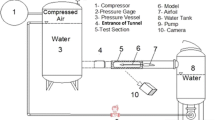Abstract
A numerical method consisted of the cavitation number correction and the model coefficient correction algorithms is presented to simulate the supercavity in water tunnel considering blockage and gravity effects based on the Logvinovich model. A model of the minimum cavitation number is also proposed based on the dimensional analysis theory, and the minimum cavitation number is formulated based on the model and numerical results using the nonlinear least square method (NLLS). The formula is verified by experiment to some extent.
Similar content being viewed by others
References
Wu Y T, Whitney A K, Brennen C. Cavity-flow wall effects and correction rules. J Fluid Mech, 1971, 49: 223–256
Chen X, Lu C J, Li J, et al. The wall effect on ventilated cavitating flows in closed cavitation tunnels. J Hydrodyn Ser B, 2008, 20(5): 561–566
Zhou J J, Yu K P, Min J X, et al. The comparative study of ventilated supercavity shape in water tunnel and infinite flow field. J Hydrodyn Ser B, 2010, 22(5): 689–696
Brennen C. A numerical solution of axisymmetric cavity flows. J Fluid Mech, 1969, 37(4): 671–688
Tulin M P. Handbook of Fluid Dynamics. New York: McGraw-Hill, 1961. 1224–1246
Karlikov V P, Sholomovich G I. Method of approximate account for the wall effect in cavitation flow around bodies in water tunnel. Fluid Dyn, 1966, 1(4): 61–64
Kawakami E, Arndt R E A. Investigation of the Behavior of Ventilated Supercavities. J Fluids Eng, 2011, 133: 091305
Serebryakov V V. Ring model for calculation of axisymmetric flows with developed cavitation (in Russian). J Hydromech, 1974, 27: 25–29
Vasin A D. The principle of independence of the cavity sections expansion (Logvinovich’s principle) as the basis for investigation on cavitation flows. USA: Defense Technical Information Center, 2001. 2–6
Savchenko Y N. Experimental Investigation of Supercavitating Motion of Bodies. In: R Van den Braembussche ed. RTO-AVT Lecture Series on “Supercavitating Flows”. Brussels, Belgium: Von Karman Institute, 2001. 43–66
Birkhoff G, Zarantonello E H. Jets, Wakes, and Cavities. New York: Academic Press, 1957. 406
Serebryakov V V. Physical-mathematical bases of the principle of independence of cavity expansion. In: S L Ceccio ed. Proceedings of the 7th International Symposium on Cavitation. Ann Arbor, Michigan, USA, 2009. 996–1009
Kinzel M P, Lindau J W, Kunz R F. Air Entrainment Mechanisms from Artificial Supercavities: Insight based on numerical simulations. Ceccio S L, ed. In: Proceedings of the 7th International Symposium on Cavitation, Ann Arbor, Michigan, USA, 2009. 815–828
Guo J H, Lu C J, Chen Y, et al. Study of ventilated cavity morphology in different gas leakage regime. J Hydrodyn Ser B, 2010, 22(5), Supplement 1: 820–826
Spurk J H, Bad K. On the gas loss from ventilated supercavities. Acta Mech, 2002, 155: 125–135
Zou W, Yu K P, Wan X H. Research on the gas-leakage rate of unsteady ventilated supercavity. J Hydrodyn Ser B, 2010, 22(5), Supplement: 778–783
Wei Y J, Cao W, Wang C, et al. Experiment Research on Character of Ventilated Supercavity. Zhuang F G, Li J C, eds. In: New trends in fluid mechanics research, Shanghai, China: Tsinghua University Press & Springer, 2009. 348–351
Lu C J, He Y S, Chen X, et al. Numerical and Experimental Research on Cavitating Flows. Zhuang F G, Li J C, eds. In: New trends in fluid mechanics research, Shanghai, China: Tsinghua University Press & Springer, 2009. 45–52
Logvinovich G V. Flows with developed cavitation (in Russian). Eng J, 1961, 1(1): 35–50
Zou W, Yu K P, Arndt R E A, et al. On the stability of supercavity with angle of attack. In: Proceedings of the 8th International Symposium on Cavitation, Singapore, 2012
Epshtein L A. Developed Cavitation Flows (in Russian). Reprinted with translation from: additions by L. A. Epshtein in book J. S. Pearsall. Moscow, Russia: Publishing House MIR, 1975. 73: 103
Yu K P, Zou W, Arndt R E A, et al. Supercavity motion with inertial force in the vertical plane. J Hydrodyn Ser B, 2012, 24(5): 752–759
Semenenko V N. Artificial supercavitation. physics and calculation. Van den Braembussche R, ed. In: RTO-AVT Lecture Series on “Supercavitating Flows”. Brussels, Belgium: Von Karman Institute, 2001. 205–237
Author information
Authors and Affiliations
Corresponding authors
Rights and permissions
About this article
Cite this article
Zou, W., Yu, K., Arndt, R.E.A. et al. On minimum cavitation number of the ventilated supercavity in water tunnel. Sci. China Phys. Mech. Astron. 56, 1945–1951 (2013). https://doi.org/10.1007/s11433-012-4917-0
Received:
Accepted:
Published:
Issue Date:
DOI: https://doi.org/10.1007/s11433-012-4917-0



